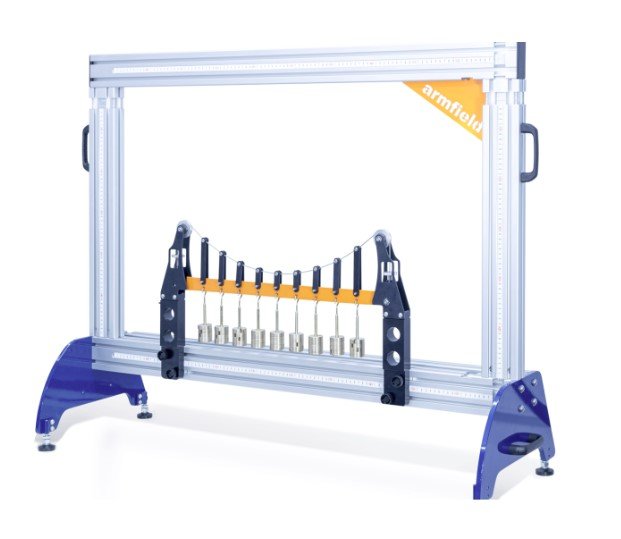When it comes to civil engineering, few feats are as inspiring as a bridge. These structures are not only practical solutions for connecting communities, but they also represent human ingenuity at its finest. A bridge spanning a roadway, river, or railway requires precise engineering to balance load distribution, tension, and compression. Structural integrity depends on careful material selection, geometric design, and environmental analysis. Engineers must calculate forces across piers, decks, and supports to ensure the bridge spanning the gap remains safe, durable, and efficient for long-term use. At Armfield, we understand these principles deeply, and our solutions are designed to empower engineers and students alike to master the science and art of bridge spanning.
Why Bridges Demand Such Precision
Building a bridge is far more than laying down concrete and steel. Each structure is a complex interplay of forces. The deck must withstand traffic loads, the piers must transfer weight safely into the ground, and the cables or beams must handle both tension and compression.
A bridge spanning a roadway, river, or railway requires precise engineering to balance load distribution, tension, and compression. Without this precision, even the smallest oversight could compromise safety. That is why every successful project begins with rigorous analysis of load paths, structural dynamics, and environmental influences like wind, temperature change, and water flow.
At Armfield, our teaching and research equipment is tailored to replicate these real-world conditions. By simulating the stresses and forces that bridges encounter, we provide engineers with the knowledge they need to create designs that endure.
The Role of Materials and Design
One of the cornerstones of bridge engineering is material science. Structural integrity depends on careful material selection, geometric design, and environmental analysis. Choosing between steel, concrete, composites, or hybrid designs is not just about cost—it is about performance under load, resistance to fatigue, and adaptability to the environment.
Equally important is the geometry of the structure. The curvature of arches, the alignment of trusses, or the tautness of suspension cables all play a vital role in determining whether a bridge will stand for decades or struggle against natural forces.
Armfield’s range of civil engineering solutions helps students and professionals investigate these variables. By working with scaled models and precision equipment, learners gain first-hand insight into how different materials and designs respond under stress.
Environmental and Safety Considerations
Modern engineering goes beyond structural performance. Today, bridges must also account for sustainability and resilience. Rising sea levels, seismic activity, and changing weather patterns all affect design decisions.
Once again, the fundamentals hold true: engineers must calculate forces across piers, decks, and supports to ensure the bridge spanning the gap remains safe, durable, and efficient for long-term use. These calculations cannot be left to chance—they require advanced analysis, robust modelling, and practical experimentation.
Armfield provides a unique advantage here. By combining theoretical understanding with experimental data, our systems allow engineers to test how environmental pressures impact bridge spanning. This holistic approach ensures that safety is never compromised, and sustainability remains a central design goal.
How Armfield Supports Bridge Spanning Education and Practice
Armfield has long been recognised as a leader in engineering education and applied research. Our equipment is trusted worldwide in universities, technical institutes, and professional training environments.
When it comes to bridge engineering, we provide complete solutions that allow students to:
- Experiment with different bridge types (beam, truss, arch, suspension).
- Measure load distribution across supports and decks.
- Study the balance of tension and compression forces.
- Explore the effects of material choice and structural geometry.
- Simulate environmental stresses to test structural resilience.
In short, Armfield has a great solution for all types of bridge spanning. Whether you are an undergraduate just beginning to explore structural mechanics, a postgraduate engaged in advanced research, or a practising engineer refining your designs, our systems provide the tools and insights you need.
Building Bridges That Last
Every bridge is a story of connection. It links cities, opens trade routes, and brings people closer together. But these connections depend on trust—trust that the structure is safe, resilient, and efficient.
That is why the fundamentals matter: a bridge spanning a roadway, river, or railway requires precise engineering to balance load distribution, tension, and compression. Structural integrity depends on careful material selection, geometric design, and environmental analysis. Engineers must calculate forces across piers, decks, and supports to ensure the bridge spanning the gap remains safe, durable, and efficient for long-term use.
At Armfield, we are proud to contribute to that trust. By equipping the next generation of engineers with the knowledge and tools they need, we are helping to ensure that bridges across the world are built to last.
Conclusion and Call to Action
The science of bridge engineering is both fascinating and essential. Precision, safety, and innovation lie at the heart of every successful design, and the right training tools make all the difference. Armfield is dedicated to providing those tools—solutions that prepare engineers for real-world challenges while pushing the boundaries of structural understanding.
If you are ready to explore how Armfield can support your teaching, research, or engineering practice in bridge spanning, we would love to hear from you.

